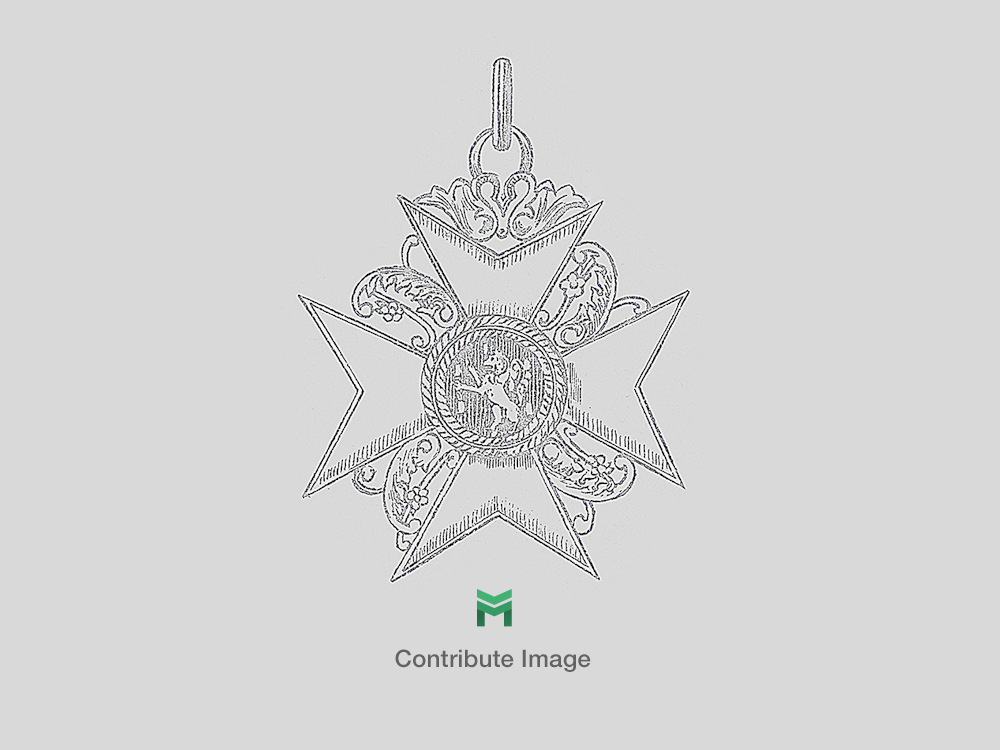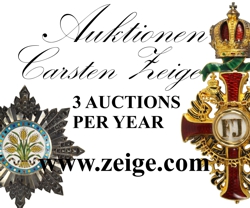Order of Merit, Type I, Military Division, Grand Cross Breast Star
SKU: 01.SXK.0105.203.01
Estimated market value:

Estimated market value:
Attributes
Physical Description
A six-sided star, constructed of silver, gold, and enamel. The decoration features two crossed swords through the centre. The star’s rays are in silver, and each ray is made up of several smaller rays. The centre medallion is pebbled and in silver, and features the inscription ‘FÜR VERDIENST UND TREUE’ (‘for merit and loyalty’) in gold. The medallion ring features an inside and outside rope-like pattern in gold, the area in between is enamelled in white and features a painted oak leaf wreath in green enamel with black shadows. The reverse is smooth and features either a vertical pinback or metal eyelets at the six tips for sewing attachment.
History
The Order of Merit was founded by King Friedrich August after his release from imprisonment in 1815. The order was conferred upon citizens of Saxony and foreign citizens in recognition of merit and virtue within distinguished civil services. The allowance of foreigners into the order was unofficially added in 1828, and was accompanied by a specific inscription.
At the conception, the order consisted of a Grand Cross, Commander, and Knight. A civil medal was indirectly counted as the 4th class. The council for the order consisted of four committees and one order secretary, all of whom were appointed by the king. It was the order council who proposed new members.
The order was originally called the "Order of Civil Merit", but the name was changed in 1849 to the "Order of Merit". On June 7, 1849, the Commander was divided into two classes. The I Class Commander is worn with a four-pointed breast star, increasing the total number of classes to five. Shortly after, in 1858, the small cross was renamed the “Cross of Honour”.
In 1866, the order grades were also awarded with crossed swords to recognise recipients for military merit and service. On December 9, 1870, King Johann decreed that if the order was awarded to persons who had already received the same class without war decoration, the swords were placed below the award's ring. When a higher class without swords was awarded to a holder of a lower class with war decoration, swords were placed above the award's ring on the higher class.
In 1876, the statutes were amended once again. The Knight’s Cross was split into the I Class and II Class Knight. Owners of the Cross of Honour could exchange their decoration for the II Class Knight. The Cross of Merit was introduced as the 6th class of the order, and could also be awarded with swords. The owners of the Golden Merit Medal could exchange it for a Cross of Merit at this time.
Type I decorations are identified by the features stated above. They do not have a surmounting crown, and the central medallions are painted. For residents, the inscription translates to “FOR LOYALTY AND MERIT” while decorations to foreigners state “FOR MERIT”.
Type II decorations are identified as those awarded from 1891 until 1918. In 1891, the order saw the addition of the royal golden crown to the Grand Cross and the Commander. The latter decoration was further split into the first and second class as well. Medallions were also applied instead of painted.
In 1905, the China expedition gave cause to the conferral of more decorations. While the statutes prescribed the order be awarded with swords, in the majority of cases however, the higher decoration without swords was awarded. Examples of swords on ring are quite uncommon.
The obverse presents the name and title of the founder and the date of creation “Friedrich August K.(önig) V. (on) Saxony D. 7 June 1815” and the reverse inscription translates to “For Merit and Loyalty”.
In March 1910, the jeweller G. A. Scharffenberg was commissioned to make simplified versions of the decorations, to lower the overall production cost. This includes gold plating and one-piece embossed medallions. The following month, the king accepted the altered manufacturing method, which consisted of the centre shield being made of one piece for all classes. Decorations prior to 1911 that are marked 'S' refer to silver used as material, not Scharffenberg.
The Type I Grand Cross Breast Star with Swords was awarded three times. In 1891, the Stars were switched from six-pointed to eight-pointed.

Versions
$6,500 USD
Silver/Gold/Enamelled
Obv: FÜR VERDIENST UND TREUE
76mm
Only three were awarded.


Comments
Sign in to comment and reply.


Scroll Top